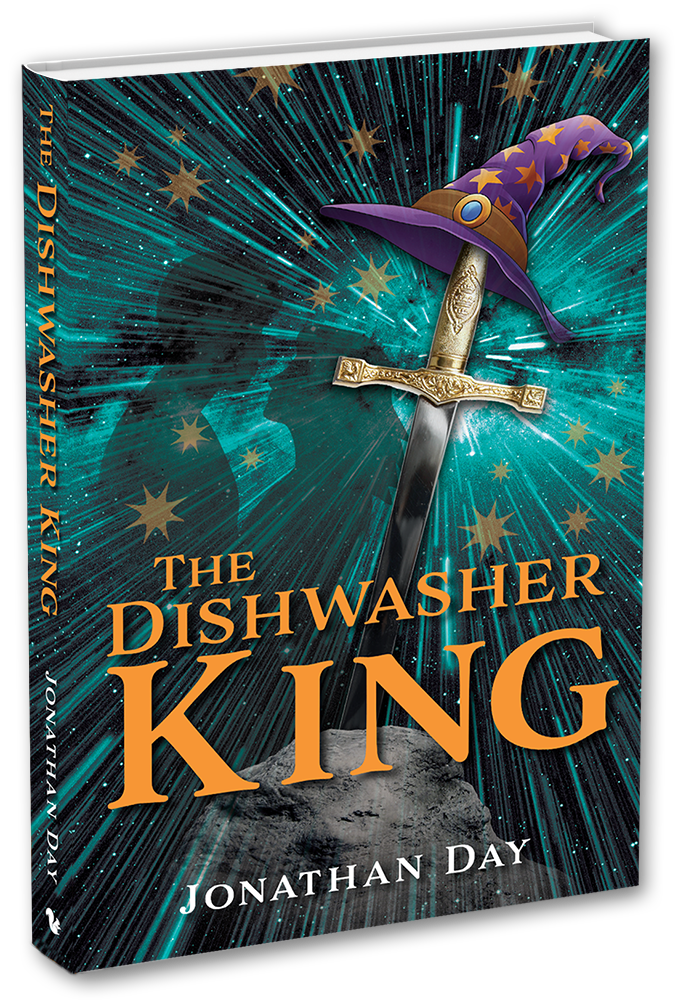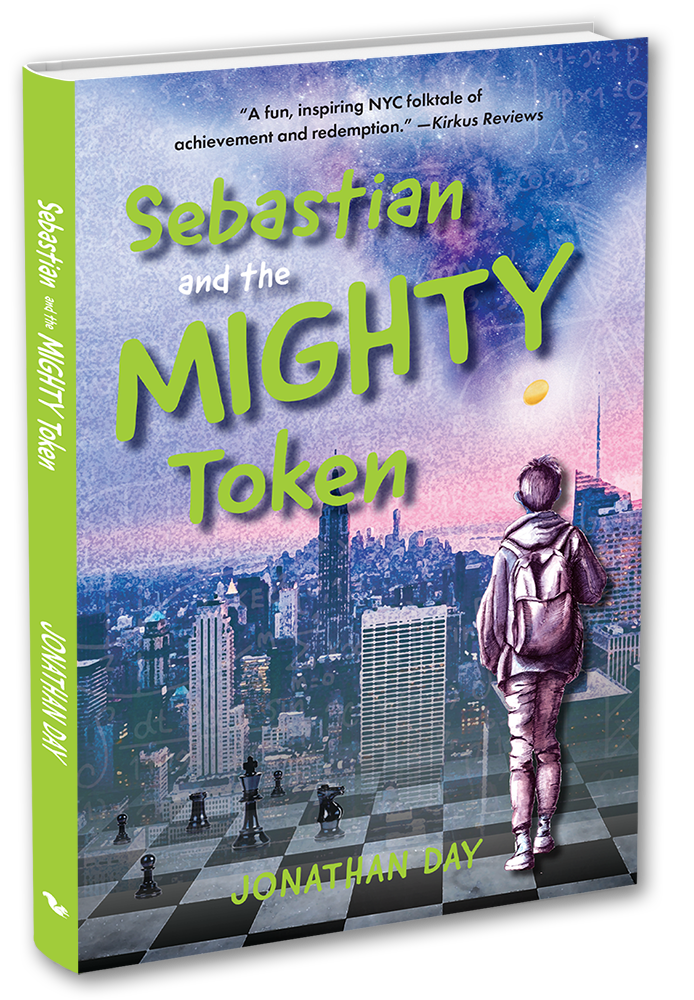
A diverting adventure combining a present-day setting with magic-infused, medieval-style battles.
In Day’s YA fantasy, the mythological Arthur Pendragon is a modern-day teen who must get back to eighth-century Camelot to claim his throne.
Merlin the wizard and Sir Lancelot time travel from 773 C.E. to present-day New York, where they locate a youth named Art Penn. Art has survived on the streets for some time after his foster parents kicked him out of their home; he washes dishes at a diner and lives at a shelter. He has trouble believing Merlin’s claim that the wizard hid the infant Art in this era to protect him from someone trying to kill him in his own time. But Camelot’s king (Art’s birth father) is now dead, and the teen’s half-sister, sorceress Morgan Le Fay, has seized the throne that’s rightfully Art’s. Morgan also time-travels to the present and goes to great lengths to eliminate her half-brother. While Merlin and Lancelot fight to get Art back to their time, Art’s 17-year-old girlfriend, Kate Cambridge, must decide if she will join him and leave her life behind.
The author injects humor into the story throughout; for example, Morgan’s minion Crow (whose cawing she understands) stamps most of his comments with sarcastic addresses from “Your Royal Svelteness” to “Your Royal Tastelessness” (on account of her flashy attire). Likewise, the time travelers often find themselves amusingly in awe of contemporary tech, including cell phones, a VR headset, and those horseless, moving “metal boxes.”
Day delivers a fast-paced tale with Art and the others constantly evading Morgan and fending off her attacks. The narrative maintains suspense—Morgan’s “shape-change” ability makes her unpredictable, and Art, once he’s in Camelot, still needs to retrieve the powerful, anvil-embedded sword Excalibur.
Art is a likable hero and Kate proves herself a self-sufficient future queen, but the fashionable and flaming-red-haired Morgan steals the novel with her tenacity and inventive murder attempts.
—Kirkus Reviews


Two New York siblings find a magical object that might help them achieve their dreams in Day’s whimsical narrative for young readers.
Young Manhattanites Sebastian and Lilly Kemp have grown up knowing Central Park like their own backyard, exploring its expanses together on roller skates and scooters. While Lilly, a 10th grader, loves the zoo, studying the snow leopards for a science project, Sebastian, a seventh grader, prefers the Chess and Checkers House, where his friend Mr. Bernstein helps him polish his game in hopes of defeating his archenemy Warner, the school chess champion. One shadow falls over the kids’ happy explorations. Their father left the family some time ago and is “traveling around the world, searching for something.” Though his mother and sister seem resigned to his absence, Sebastian refuses to give up hope. He is a dreamer at heart, even though his nightly dream escapades have stopped since his father’s departure. When his fear of facing another chess defeat by Warner threatens to sink Sebastian into permanent hopelessness, Mr. Bernstein decides that strong measures are called for. He gives Sebastian his prized possession, an old New York subway token on a neck chain, which has interesting powers. Skeptical but intrigued, Sebastian soon finds that the “mighty token” brings both great success and serious responsibility. Day has created a likably quirky protagonist in Sebastian, who is both kind and perceptive. He skillfully conveys the sarcastic vulnerability of the tweenager in such succinctly eloquent descriptions as “suit-job man” for a businessperson and Sebastian’s defensively sneering reaction to another student’s European vacation, “They’ll stay in duh-lux hotels and eat at duh-lux restaurants that probably don’t even serve pizza.” Though some plot elements seem derivative—the missing father narrative is reminiscent of Suzanne Collins’ Underland Chronicles, for example—the overall story is compelling and empowering.
A fun, inspiring NYC folktale of achievement and redemption.
—Kirkus Reviews


In this middle-grade sequel, a pathologically shy New York City boy and an aspiring young race car driver try to help each other overcome their fears.
Twelve-year-old Sebastian Kemp is a whiz at math. But he’s less adept with people, and though signed up for the New York State Regional Teen Math Olympics, he cannot summon the courage to get one foot in the door. Sebastian’s social anxiety also prevents him from making friends. (In fact, his only pal turns out to be an artificial intelligence construct of Sebastian’s own devising.) He would like to join in, but he overthinks things and shies away from spontaneity. Then Sebastian sees Naomi, his sister’s 16-year-old best friend, for the first time since “her father’s memorial service.” Naomi, an experienced go-kart driver, is fearsome and confident. She is applying to an elite race car driving school overseas and needs to win one more competition to qualify. Naomi thinks Sebastian’s shyness is an excuse, not an affliction. She urges him to just go for it and not look back. But Naomi has her own problems. Apart from dyslexia, which she takes in stride, she has a chronic fear of flying that saps her ferocious competitiveness. Can Sebastian and Naomi take strength from each other’s bravery and determination? Day writes in the first person, present tense, from Sebastian’s point of view. The narrative is convincing and unaffected, and Sebastian’s inner thoughts come across as age-appropriate. The dialogue for the most part is naturalistic. Sebastian is a sympathetic and well-drawn character, and his struggles will resonate with readers who have ever felt disconnected or unsure of themselves. The other players are similarly memorable—Naomi, with her unfiltered exuberance; Sebastian’s dad, Arthur, who’s still coping with an existential crisis brought on by the death of his best friend; and even minor characters like Harold, Arthur’s colleague, who suffers from intense social anxiety and uses text-to-speech technology to express his thoughts. In the people around him, Sebastian comes to see that he isn’t alone in having issues to deal with. The story moves quickly, and though the transition between scenes can be abrupt, this too is somehow redolent of Sebastian’s awkwardness in communicating. All told, young readers will approve.
Quirky and upbeat; a satisfying tale of inner courage and friendship.
—Kirkus Reviews


Day’s third novel about a smart but shy New York City boy finds its hero involved with a group of vigilante computer hackers.
Thirteen-year-old Sebastian Kemp is in a bad place. To prove his innocence in a cheating scam, he tried to hack his school’s computer system—and was caught, expelled, and sent to the “110 percent awful” Berkowitz High, full of kids who “bombed out” of other schools. The place isn’t all bad: Sebastian is welcomed by 15-year-old Jazmin, who has a baby daughter, and by Marty, a wannabe actor who enrolled because of the school’s theater program. But he’s terrorized by Sammy the Psycho, a bully who demands that Sebastian help him cheat on a math quiz. Unwilling to do it, Sebastian instead seeks out the Totos—a group of teenage runaways–turned–computer hackers who operate from an abandoned train car beneath Grand Central Terminal. Sebastian learns to hack and hopes to protect himself by digging up dirt on Sammy the Psycho. He finds himself empowered by the Totos’ righteous vigilantism, but is he being drawn into something more nefarious? As the answer emerges, Sebastian is confronted by teen pregnancy and homelessness, police corruption, and the insidious practice of grooming potential victims of abuse. He’s a likable protagonist—young for his age but good-hearted and nonjudgmental—and the other characters evince real personality. Day writes in the first person, present tense, narrating with a prose style that gives easy access to Sebastian’s thoughts and feelings, and the well-paced plot rattles along and avoids predictability. Some readers may quibble with how easily Sebastian becomes a master hacker, but even this fits in with the authorial injunction for readers not to be too readily accepting. Younger readers of this novel will learn, as Sebastian does, that problems rarely have easy solutions—and if something seems too good to be true, it probably is.
A well-wrought cautionary tale that’s fast-moving and full of surprises.
—Kirkus Reviews